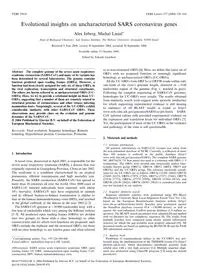
2004 Evolutional insights on uncharacterized SARS coronavirus genes PDF
Preview 2004 Evolutional insights on uncharacterized SARS coronavirus genes
Evolutional insights on uncharacterized SARS coronavirus genes Alex Inberg, Michal Linial* Dept of Biological Chemistry, Life Science Institute, The Hebrew University, Jerusalem, 91904 Israel Received 9 June 2004; revised 30 September 2004; accepted 30 September 2004 Available online 13 October 2004 Edited by Takashi Gojobori Abstract The complete genome of the severe acute respiratory syndrome coronavirus (SARS-CoV) and many of its variants has been determined by several laboratories. The genome contains fourteen predicted open reading frames (ORFs). However, a function had been clearly assigned for only six of these ORFs, in the viral replication, transcription and structural constituents. The others are herein referred to as uncharacterized ORFs (UC- ORFs). Here, we try to provide a relational insight on those UC- ORFs, suggesting that a number of them are remotely related to structural proteins of coronaviruses and other viruses infecting mammalian hosts. Surprisingly, several of the UC-ORFs exhibit considerable similarity with other SARS-CoV ORFs. These observations may provide clues on the evolution and genome dynamics of the SARS-CoV. � 2004 Published by Elsevier B.V. on behalf of the Federation of European Biochemical Societies. Keywords: Viral evolution; Sequence homology; Remote homolog; Hypothetical protein; Coronavirus; Proteome 1. Introduction A novel virus, discovered in April 2003, is responsible for the severe acute respiratory syndrome (SARS), a disease that was originally exposed in Guangdong Province, China in late 2002. The syndrome is a condition characterized by an atypical pneumonia, efficient transmission and high mortality rate. Presently, the SARS coronavirus (SARS-CoV) has spread to more than 30 countries all over the world. Over 8000 cases of SARS-CoV infected individuals were reported, with about 10% mortality. SARS-CoV may have originated in animals and its efficient human-to-human transmission is similar to that of the human immunodeficiency virus (HIV), and resulted in the global outbreak of the disease in the year 2003 [1,2]. The SARS-CoV genome is �30 000 nucleotides long, with a few tens of nucleotides which vary among the different isolates [3–5]. All predicted open reading frames (ORFs) are divided into two groups: (i) those with a clear homology to other coronaviruses and for which viral functions are proposed; such ORFs include the replicase and the structural ORFs; (ii) those with no clear homology to any known genes and often referred to as non-structural ORFs [6]. Here, we define this latter set of ORFs with no proposed function or seemingly significant homology as uncharacterized ORFs (UC-ORFs). All the UC-ORFs from ORF3a to ORF9b reside within only one-tenth of the virus’s genomic length, clustered in �3160 nucleotides region of the genome (Fig. 1, marked in gray). Following the complete sequencing of SARS-CoV genomes, homologies for UC-ORFs were sought. The results obtained from similarity search tools suggest some sporadic similarities for which supporting experimental evidence is still missing (a summary of all BLAST results is found at http:// www.ncbi.nlm.nih.gov/genomes/SARS/sarsptt.html). SARS- CoV infected culture cells provided experimental evidence on the expression and translation levels for individual ORFs [7]. Yet, the participation of most of the UC-ORFs in the virulence and pathology of the virus is still questionable. 2. Materials and methods 2.1. Genomic information All genomic information on SARS-CoV variants was taken from the non-redundant database of NCBI. Currently, a collection of more than 100 isolates is archived in the public database (http:// www.ncbi.nlm.nih.gov/genomes/SARS/). The complete SARS genome NC_004718(29, 751 base pairs) was used as a reference with ORFs 1–9 terminology. The ORFs were divided into structurally and/or func- tionally known group (ORF1a, ORF1b, ORF2, ORF4, ORF5 and ORF9a) and the UC-ORFs group. The reference nucleotide coordi- nates for the UC-ORFs are as follows: ORF3a (25268–26092) ORF3b (25689–26153), ORF6 (27074–27265), ORF7a (27273–27641), ORF7b (27638–27772), ORF8a (27779–27898), ORF8b (27864–28118), and ORF9b (28130–28426). ORF9c (28583–29621) is considered false and was not included in our analysis. 2.2. Sequence similarity search Sequence similarity searches were performed using WU-Blast2 (Washington University Basic Local Alignment Search Tool, Ver. 2.0), based on the European Bioinformatics Institute website (http:// www.ebi.ac.uk/blast2/index.html). Searches were performed against the SwissProt database (version 43.4 �150,000 entries), as well as against the non-redundant UniProt protein database (1.4 million se- quences). The BLAST search parameters were adjusted [8] and applied with no filtration for low complexity sequences [9]. The results from multiple searches were compared using closely related substitution matrices for which the gap penalties were properly adjusted [10]. All presented results are based on applying the BLOSUM 40 and the PAM 200 substitution matrices. 2.3. Analysis tools Prediction of transmembrane helices in the UC-ORFs was per- formed using the implementation of the TMHMM system [11] (http:// phobius.cgb.ki.se/), which discriminates membrane proteins from soluble ones with a very high accuracy [12]. Multiple sequence align- ment was performed using ClustalW program [13] using the default parameters. * Corresponding author. Fax: +97-226-586-448. E-mail address:
